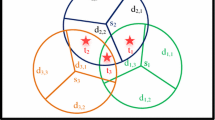Abstract
In recent years, directional sensor networks composed of directional sensors have attracted a great deal of attention due to their extensive applications. The main difficulties associated with directional sensors are their limited battery power and restricted sensing angle. Moreover, each target may have a different coverage quality requirement that can make the problem even more complicated. Therefore, satisfying the coverage quality requirement of all the targets in a specific area and maximizing the network lifetime, known as priority-based target coverage problem, has remained a challenge. As sensors are often densely deployed, organizing the sensor directions into several cover sets and then activating these cover sets successively is a promising solution to this problem. In this paper, we propose a learning automata-based algorithm to organize the directional sensors into several cover sets in such a way that each cover set can satisfy coverage quality requirement of all the targets. In order to verify the performance of the proposed algorithm, several simulations were conducted. The obtained results showed that the proposed algorithm was successful in extending the network lifetime.






Similar content being viewed by others
References
Ai, J., & Abouzeid, A. (2006). Coverage by directional sensors in randomly deployed wireless sensor networks. Journal of Combinatorial Optimization, 11(1), 21–41.
Amac Guvensan, M., & Gokhan Yavuz, A. (2011). On coverage issues in directional sensor networks: A survey. Ad Hoc Networks, 9(7), 1238–1255.
Cardei, M., Thai, M. T., Yingshu, L., & Weili, W. (2005). Energy-efficient target coverage in wireless sensor networks. In Proceedings of 24th annual joint conference of the IEEE computer and communications societies (INFOCOM) (pp. 1976–1984). Miami, FL, USA.
Cardei, M., & Du, D.-Z. (2005). Improving wireless sensor network lifetime through power aware organization. Wireless Networks, 11(3), 333–340.
Gil, J.-M., & Han, Y.-H. (2011). A target coverage scheduling scheme based on genetic algorithms in directional sensor networks. Sensors, 11(2), 1888–1906.
Huiqiang, Y., Deying, L., & Hong, C. (2010). Coverage quality based target-oriented scheduling in directional sensor networks. In Proceedings of international conference on communications, pp. 1–5.
Kim, Y.-H., Han, Y.-H., Jeong, Y.-S., & Park, D.-S. (2013). Lifetime maximization considering target coverage and connectivity in directional image/video sensor networks. The Journal of Supercomputing, 65(1), 365–382.
Lotf, J. J., Hosseinzadeh, M., Ghazani, S., & Alguliev, R. M. (2012). Applications of learning automata in wireless sensor networks. Procedia Technology, 1, 77–84.
Mohamadi, H., Ismail, A., Salleh, S., & Nodehi, A. (2013). Learning automata-based algorithms for finding cover sets in wireless sensor networks. The Journal of Supercomputing, 66(3), 1533–1552.
Mohamadi, H., Ismail, A. S., & Salleh, S. (2013). Utilizing distributed learning automata to solve the connected target coverage problem in directional sensor networks. Sensors and Actuators A: Physical, 198(1), 21–30.
Mohamadi, H., Ismail, A., Salleh, S., & Nodehi, A. (2013). Learning automata-based algorithms for solving the target coverage problem in directional sensor networks. Wireless Personal Communications, 73(3), 1309–1330.
Mohamadi, H., Ismail, A., & Salleh, S. (2013). A learning automata-based algorithm for solving coverage problem in directional sensor networks. Computing, 95(1), 1–24.
Mohamadi, H., Ismail, A., & Salleh, S. (2014). Solving target coverage problem using cover sets in wireless sensor networks based on learning automata. Wireless Personal Communications, 75(1), 447–463.
Mostafaei, H., & Meybodi, M. R. (2013). Maximizing lifetime of target coverage in wireless sensor networks using learning automata. Wireless Personal Communications, 71(2), 1461–1477.
Najim, K., & Poznyak, A. S. (1994). Learning automata: Theory and applications. New York: Printice-Hall.
Nicopolitidis, P., Papadimitriou, G. I., Pomportsis, A. S., Sarigiannidis, P., & Obaidat, M. S. (2011). Adaptive wireless networks using learning automata. Wireless Communications, 18(2), 75–81.
Thathachar, M. A. L., & Harita, B. R. (1987). Learning automata with changing number of actions. IEEE Transactions on Systems, Man and Cybernetics, 17(6), 1095–1100.
Ting, C.-K., & Liao, C.-C. (2010). A memetic algorithm for extending wireless sensor network lifetime. Information Sciences, 180(24), 4818–4833.
Torkestani, J. A. (2012). An adaptive learning automata-based ranking function discovery algorithm. Journal of Intelligent Information Systems, 39(2), 441–459.
Wang, J., Niu, C., & Shen, R. (2009). Priority-based target coverage in directional sensor networks using a genetic algorithm. Computers & Mathematics with Applications, 57(11–12), 1915–1922.
Wang, B. (2011). Coverage problems in sensor networks: A survey. ACM Computing Surveys, 43(4), 1–53.
Yanli, C., Wei, L., Minglu, L., & Xiang-Yang, L. (2009). Energy efficient target-oriented scheduling in directional sensor networks. IEEE Transactions on Computers, 58(9), 1259–1274.
Zorbas, D., Glynos, D., Kotzanikolaou, P., & Douligeris, C. (2010). Solving coverage problems in wireless sensor networks using cover sets. Ad Hoc Networks, 8(4), 400–415.
Acknowledgments
The authors would like to thank Universiti Teknologi Malaysia and the Malaysian Ministry of Education for providing funds and support with research Grants No. 01G14 and 04H43 for this research.
Author information
Authors and Affiliations
Corresponding author
Rights and permissions
About this article
Cite this article
Mohamadi, H., Salleh, S. & Ismail, A.S. A Learning Automata-Based Solution to the Priority-Based Target Coverage Problem in Directional Sensor Networks. Wireless Pers Commun 79, 2323–2338 (2014). https://doi.org/10.1007/s11277-014-1987-5
Published:
Issue Date:
DOI: https://doi.org/10.1007/s11277-014-1987-5




